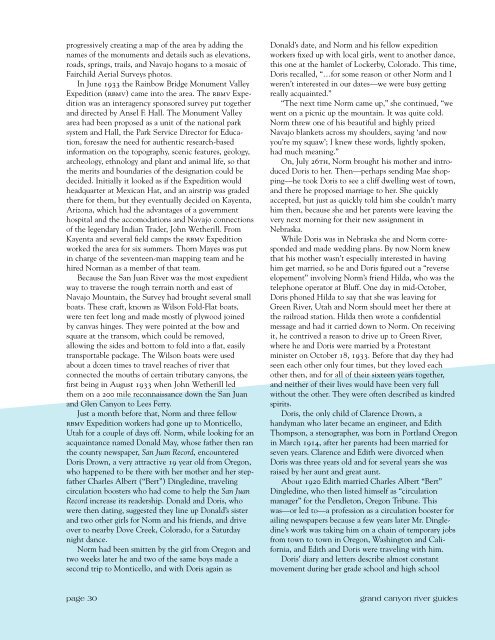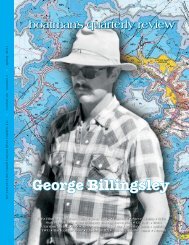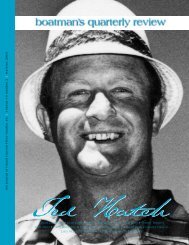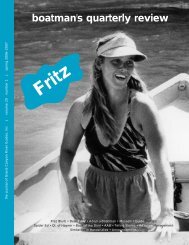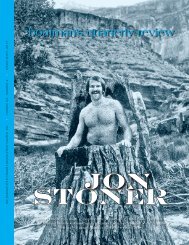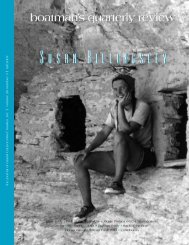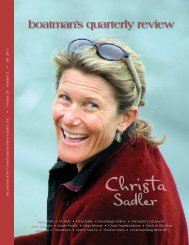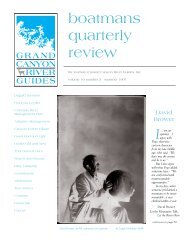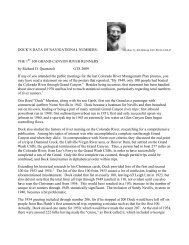spring 04 / 17:1 - Grand Canyon River Guides
spring 04 / 17:1 - Grand Canyon River Guides
spring 04 / 17:1 - Grand Canyon River Guides
Create successful ePaper yourself
Turn your PDF publications into a flip-book with our unique Google optimized e-Paper software.
progressively creating a map of the area by adding the<br />
names of the monuments and details such as elevations,<br />
roads, <strong>spring</strong>s, trails, and Navajo hogans to a mosaic of<br />
Fairchild Aerial Surveys photos.<br />
In June 1933 the Rainbow Bridge Monument Valley<br />
Expedition (rbmv) came into the area. The rbmv Expedition<br />
was an interagency sponsored survey put together<br />
and directed by Ansel F. Hall. The Monument Valley<br />
area had been proposed as a unit of the national park<br />
system and Hall, the Park Service Director for Education,<br />
foresaw the need for authentic research-based<br />
information on the topography, scenic features, geology,<br />
archeology, ethnology and plant and animal life, so that<br />
the merits and boundaries of the designation could be<br />
decided. Initially it looked as if the Expedition would<br />
headquarter at Mexican Hat, and an airstrip was graded<br />
there for them, but they eventually decided on Kayenta,<br />
Arizona, which had the advantages of a government<br />
hospital and the accomodations and Navajo connections<br />
of the legendary Indian Trader, John Wetherill. From<br />
Kayenta and several field camps the rbmv Expedition<br />
worked the area for six summers. Thorn Mayes was put<br />
in charge of the seventeen-man mapping team and he<br />
hired Norman as a member of that team.<br />
Because the San Juan <strong>River</strong> was the most expedient<br />
way to traverse the rough terrain north and east of<br />
Navajo Mountain, the Survey had brought several small<br />
boats. These craft, known as Wilson Fold-Flat boats,<br />
were ten feet long and made mostly of plywood joined<br />
by canvas hinges. They were pointed at the bow and<br />
square at the transom, which could be removed,<br />
allowing the sides and bottom to fold into a flat, easily<br />
transportable package. The Wilson boats were used<br />
about a dozen times to travel reaches of river that<br />
connected the mouths of certain tributary canyons, the<br />
first being in August 1933 when John Wetherill led<br />
them on a 200 mile reconnaissance down the San Juan<br />
and Glen <strong>Canyon</strong> to Lees Ferry.<br />
Just a month before that, Norm and three fellow<br />
rbmv Expedition workers had gone up to Monticello,<br />
Utah for a couple of days off. Norm, while looking for an<br />
acquaintance named Donald May, whose father then ran<br />
the county newspaper, San Juan Record, encountered<br />
Doris Drown, a very attractive 19 year old from Oregon,<br />
who happened to be there with her mother and her stepfather<br />
Charles Albert (“Bert”) Dingledine, traveling<br />
circulation boosters who had come to help the San Juan<br />
Record increase its readership. Donald and Doris, who<br />
were then dating, suggested they line up Donald’s sister<br />
and two other girls for Norm and his friends, and drive<br />
over to nearby Dove Creek, Colorado, for a Saturday<br />
night dance.<br />
Norm had been smitten by the girl from Oregon and<br />
two weeks later he and two of the same boys made a<br />
second trip to Monticello, and with Doris again as<br />
Donald’s date, and Norm and his fellow expedition<br />
workers fixed up with local girls, went to another dance,<br />
this one at the hamlet of Lockerby, Colorado. This time,<br />
Doris recalled, “…for some reason or other Norm and I<br />
weren’t interested in our dates—we were busy getting<br />
really acquainted.”<br />
“The next time Norm came up,” she continued, “we<br />
went on a picnic up the mountain. It was quite cold.<br />
Norm threw one of his beautiful and highly prized<br />
Navajo blankets across my shoulders, saying ‘and now<br />
you’re my squaw’; I knew these words, lightly spoken,<br />
had much meaning.”<br />
On, July 26th, Norm brought his mother and introduced<br />
Doris to her. Then—perhaps sending Mae shopping—he<br />
took Doris to see a cliff dwelling west of town,<br />
and there he proposed marriage to her. She quickly<br />
accepted, but just as quickly told him she couldn’t marry<br />
him then, because she and her parents were leaving the<br />
very next morning for their new assignment in<br />
Nebraska.<br />
While Doris was in Nebraska she and Norm corresponded<br />
and made wedding plans. By now Norm knew<br />
that his mother wasn’t especially interested in having<br />
him get married, so he and Doris figured out a “reverse<br />
elopement” involving Norm’s friend Hilda, who was the<br />
telephone operator at Bluff. One day in mid-October,<br />
Doris phoned Hilda to say that she was leaving for<br />
Green <strong>River</strong>, Utah and Norm should meet her there at<br />
the railroad station. Hilda then wrote a confidential<br />
message and had it carried down to Norm. On receiving<br />
it, he contrived a reason to drive up to Green <strong>River</strong>,<br />
where he and Doris were married by a Protestant<br />
minister on October 18, 1933. Before that day they had<br />
seen each other only four times, but they loved each<br />
other then, and for all of their sixteen years together,<br />
and neither of their lives would have been very full<br />
without the other. They were often described as kindred<br />
spirits.<br />
Doris, the only child of Clarence Drown, a<br />
handyman who later became an engineer, and Edith<br />
Thompson, a stenographer, was born in Portland Oregon<br />
in March 1914, after her parents had been married for<br />
seven years. Clarence and Edith were divorced when<br />
Doris was three years old and for several years she was<br />
raised by her aunt and great aunt.<br />
About 1920 Edith married Charles Albert “Bert”<br />
Dingledine, who then listed himself as “circulation<br />
manager” for the Pendleton, Oregon Tribune. This<br />
was—or led to—a profession as a circulation booster for<br />
ailing newspapers because a few years later Mr. Dingledine’s<br />
work was taking him on a chain of temporary jobs<br />
from town to town in Oregon, Washington and California,<br />
and Edith and Doris were traveling with him.<br />
Doris’ diary and letters describe almost constant<br />
movement during her grade school and high school<br />
page 30<br />
grand canyon river guides


